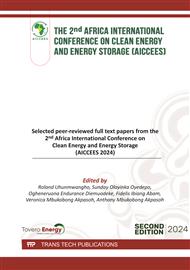p.195
p.205
p.227
p.245
p.267
p.279
p.291
p.309
p.321
Clay-Based Microbial Fuel Cell System for Petroleum Contaminated Wastewater Treatment and Green Energy Generation
Abstract:
The increasing demand for energy and the growing concern for environment pollution have led to the exploration of sustainable and efficient methods for wastewater treatment coupled with energy recovery. This study was focusing on the application of clay based (MFC) microbial fuel cell as a novel approach to treat petroleum wastewater while simultaneously generating electrical energy by using microorganisms extracted from diesel oil-contaminated soil collected from old garage. In this study, microbial fuel cells (MFCs) were constructed using low cost ceramic cylindrical pot (900ml) as an ion exchange membrane. An inoculum derived from oil-contaminated soil, 10% of the volume of the anode inoculum was fed to the anode chamber for MFC1, MFC2 and no inoculation was added to the MFC control. The cathode chamber was filled with 1M potassium ferricyanide in a 1M phosphate buffer solution at a ratio of 1:1. All MFCs were operated in batch mode with synthetic petroleum wastewater containing (810 ml) for 30 days for open circuit voltage and at an external resistance of 10Ω, 100Ω, and 1000 Ω for 14 days for closed circuit voltage. Carbon cloth (projected surface area of 546cm2and 455.22 cm2) was used as both the cathode and anode respectively. The treatment efficiency of clay-based MFCs were evaluated by the removal efficiencies of COD and BOD. For MFC1, BOD removal efficiency of 89%, COD removal efficiency was 96%, and maximum daily open circuit voltage of 188.92 mV. MFC2 demonstrated BOD removal efficiency of 91%, COD removal efficiency of 98%, and a maximum average daily open circuit voltage of 210.35 mV. In contrast, MFC control displayed lower removal efficiencies with BOD removal efficiency of 49%, COD removal efficiency of 30%, and a maximum average daily open circuit voltage of 58.28 mV. The maximum power density achieved was 9.99µW/cm2 for the highest performing MFC2.These results highlights the effectiveness of MFC1 and MFC2 in terms of organic matter removal and power generation compared to MFC control, displaying the potential of clay-based MFCs for wastewater treatment and energy production. This research just laid a foundation for the use of clay based MFC in treatment of petroleum wastewater and energy recovery, more studies have to be carried out to optimize and maximise its efficiency.
Info:
Periodical:
Pages:
321-338
Citation:
Online since:
February 2025
Authors:
Price:
Сopyright:
© 2025 Trans Tech Publications Ltd. All Rights Reserved
Share:
Citation:


